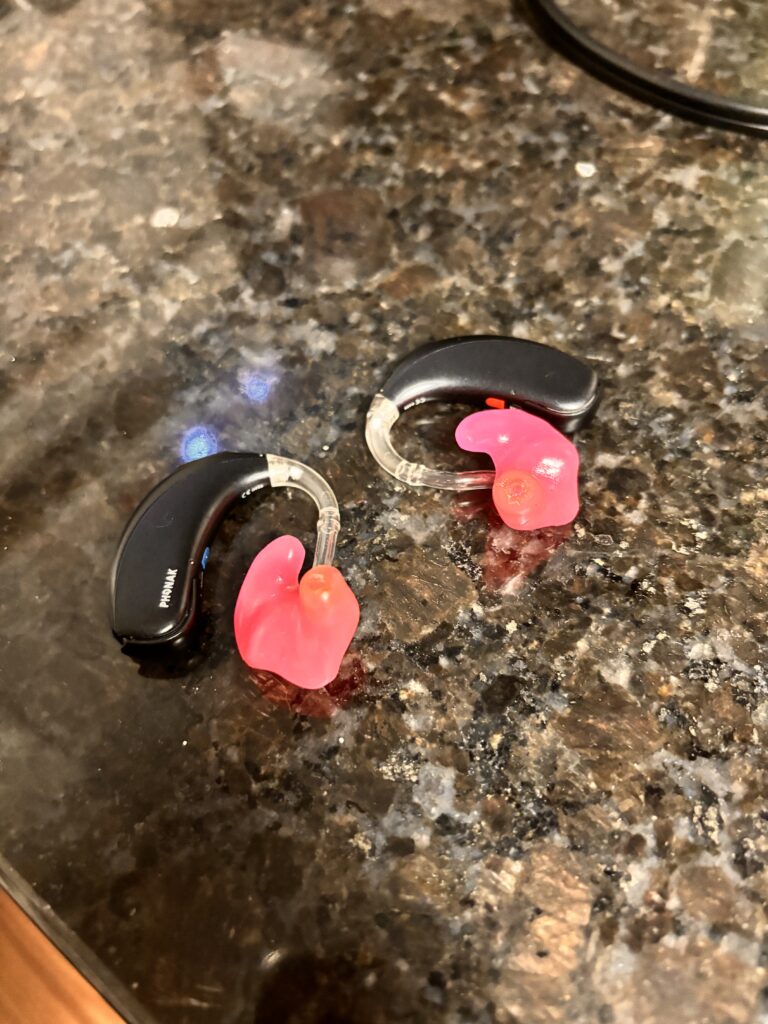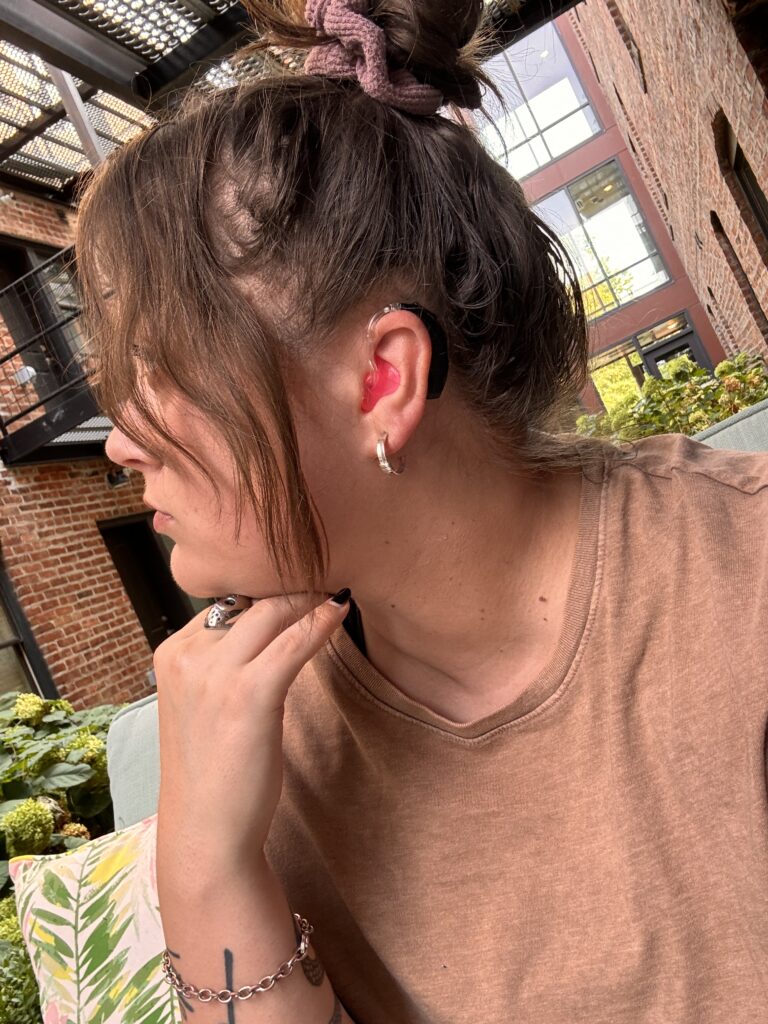My Experiences Before and After Getting Hearing Aids
by Blog Writers
By Rikki Poynter
In August 2021 at 30 years old, I got my first pair of hearing aids after being diagnosed with hearing loss at 11. Why didn’t I get them when I was 11? I qualified for them, but they were too expensive. I don’t know the average cost of hearing aids back in 2002, but now in 2024, the average cost is $4,000 for a pair. With only one income in the household, a truck driver’s salary, there was no way we could afford them. And unfortunately, most insurance companies tend to not pay for them.
(This is also partially due to the fact that when it came to my accessibility needs, they were ignored. My parents, even my deaf mother, did not put in the effort to learn what I needed and give me the tools to know what I needed as well.)
I grew up with zero additional accommodations for my deafness. In school, I had to go through class without ASL interpreters and notetakers. I had to watch films and documentaries in school with captions. I had to participate in reading aloud in English class without any way of knowing for sure where we were on the page. My grades suffered and I graduated from high school with a 2.6 GPA.
 My social life took a hit. One-on-one socialization was okay, but being in a group setting was difficult. Being in two relationships with hearing men and going to family dinners where none of them signed (except for my first ex-boyfriend) meant experiencing Dinner Table Syndrome, where a deaf person is surrounded by hearing people who don’t know sign language and put little effort into equal communication which causes the deaf person to miss out on conversation.
My social life took a hit. One-on-one socialization was okay, but being in a group setting was difficult. Being in two relationships with hearing men and going to family dinners where none of them signed (except for my first ex-boyfriend) meant experiencing Dinner Table Syndrome, where a deaf person is surrounded by hearing people who don’t know sign language and put little effort into equal communication which causes the deaf person to miss out on conversation.
As the years went by and my hearing loss became more progressive, it was becoming more difficult to do my work. I’ve been a content creator for over a decade and I speak in most of my videos. I edit my own videos, and for a few years, I had a company who would sponsor my captions. Unfortunately, that eventually ended, and I had to do the captions myself. Editing, and especially captioning, was becoming too difficult as no headphones were good enough for me to be able to understand myself. My speaking engagements on my own or at conferences were fine with the help of an ASL interpreter and captions, but once they were off the clock and it was time for the social events, I was left on my own. Attempting to lip read people while extremely loud music is playing on top of a few alcoholic drinks especially was practically impossible.
Then around April 2021, I learned about Vocational Rehabilitation Services (VR), an organization that aids disabled people in preparing for and finding a job. My friends have told me that they’ve received various things from them for their schooling and businesses like iPads, video phones, laptops, and, of course, hearing aids. So I sent in an email and crossed my fingers.
After a few months of going over my business, finances, a new audiogram, and waiting to be approved, I was fitted for and then received my hearing aids the following August, all for free.
Getting them activated was definitely an experience. I went from barely being able to hear anything at all to suddenly being bombarded with loud voices in a matter of seconds. Hearing people are used to seeing edited videos of babies and adults smiling and crying upon hearing aid and cochlear implant activation. My experience, however, was pretty neutral. “Oh, wow. That’s loud.” I didn’t cry tears of joy like the people in the videos.
(For the record, I’ve nothing against the people in the videos and their emotions are valid. I, as many others, question hearing people’s reaction to them when they’ve only seen one experience. An experience that is edited and doesn’t show the whole picture.)
 My hearing aids are the Phonak Naida P50 with black hardware and pink earmolds. (I’m slightly kicking myself for not getting black earmolds now.) They have Bluetooth, something I absolutely needed for work. I could stream my entertainment and my work content directly into my ears and I understood so much more than when I was using headphones and AirPods. When I finally figured out that I could connect them to my iMac, it changed the editing game for me. And even better, I got to take extra joy in my third rewatch of One Tree Hill.
My hearing aids are the Phonak Naida P50 with black hardware and pink earmolds. (I’m slightly kicking myself for not getting black earmolds now.) They have Bluetooth, something I absolutely needed for work. I could stream my entertainment and my work content directly into my ears and I understood so much more than when I was using headphones and AirPods. When I finally figured out that I could connect them to my iMac, it changed the editing game for me. And even better, I got to take extra joy in my third rewatch of One Tree Hill.
My social life became easier, especially having moved to Omaha last year. The downside is that it does feel like I have to hold the burden of making communication easier for the person I’m talking to rather than the other person trying to make it an equal effort, which is how it was before getting the hearing aids.
Editing and captioning my work is so much easier. It’s not perfect and I still struggle to understand myself sometimes especially if I’m not talking directly to the camera, but it is a drastic improvement compared to five years ago. I can get around better at networking during events. It’s still difficult to understand everything if I’m at a panel or workshop, so I still request ASL interpreters for that.
While there has been a drastic change for the better, that doesn’t mean they’re perfect. I still can’t make regular phone calls. I still have to use an IP relay (think TTY, the typing telephone, but online). I still have to use captions while watching online content. I still need captions when going to the movie theater and watching TV.
Getting over my nerves and taking a chance with VR is by far one of the best decisions I’ve made in my life. I know my life wouldn’t be the way it is now had I not gotten them, which is an unfortunate thing to say, but it’s true.
But what I want people reading this to know is that hearing aids and cochlear implants are a big personal decision. Some of us want them, some of us don’t. Some of us qualify for them, some of us don’t. Sometimes they work for us, and sometimes they don’t work at all. Everyone is different and just because my experience has been a good one, doesn’t mean it’ll be the same for the next deaf person one comes across.
Rikki Poynter is a disabled (deaf, chronic pain and fatigue) accessibility consultant, writer, public speaker, and content creator. Originally a beauty vlogger on YouTube, she moved onto talking about her journey growing up as a mainstreamed deaf person trying to find her deaf identity and community all while trying to navigate an inaccessible world. Since 2013, she has talked about making the Internet accessible to deaf and hard of hearing people with captions, transcripts, and more. Her work has gotten the attention of many news outlets and she has worked with Apple, FireFox, Samsung, Google, and more.






